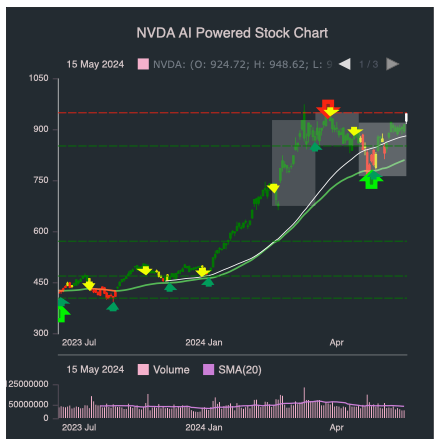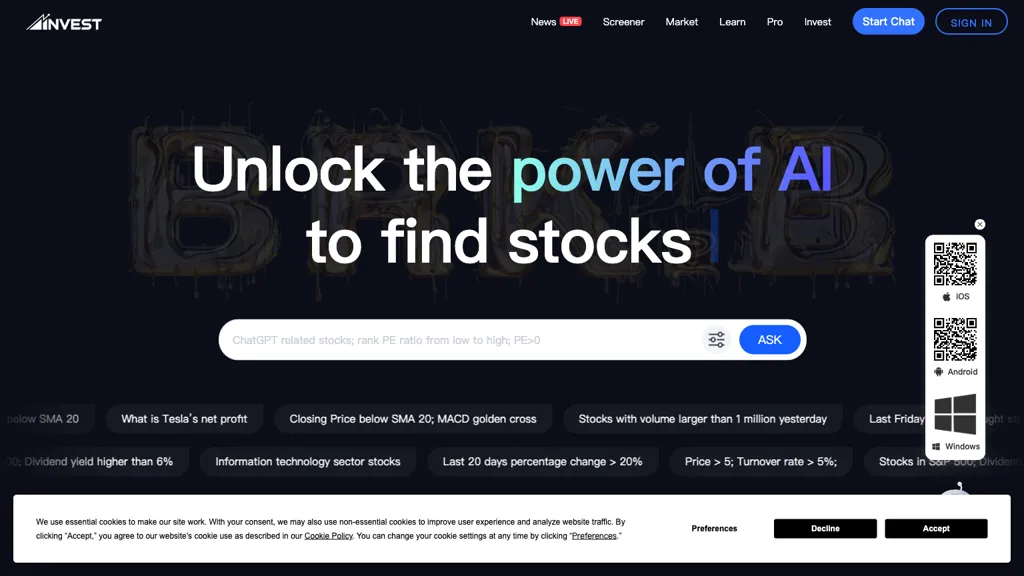Market coverage plays a crucial role in evaluating AI stock-Predicting/Analyzing trading platform because it determines the access you have to a broad array of financial markets. Platforms that have a wide market coverage allow you to diversify and explore global opportunities as well as adapt to various trading strategies. Here are 10 best strategies to help you assess the market coverage provided by these platforms.
1. Evaluate Supported Asset Classes
Stocks: Make sure that the platform has stocks from the top stock exchanges, including NYSE, NASDAQ and LSE.
ETFs - Check to see the platform you use supports an extensive selection of ETFs which offer exposure in a number of diverse regions, sectors or themes.
Futures and options. See if your platform offers derivatives, such as options, futures or any other leveraged instrument.
Commodities and Forex. Check to see if there are forex pairs that are available, in addition to precious metals, commodities for energy and agricultural commodities.
Cryptocurrencies Find out if the platform can support popular cryptocurrencies like Bitcoin, Ethereum, and altcoins.
2. Check the coverage area
Global markets - Ensure that the platform has the capacity to cover every major market around the globe, including North America (including Canada), Europe, Asia-Pacific markets as well as emerging ones.
Regional focus: Find out whether the platform is focused on particular market segments or regions that are in line with your preferences for trading.
Local exchanges - Examine for local or regional exchanges available which are relevant to your area and strategy.
3. Compare Real-Time and. Data that is delayed
Real-time data is essential to speed up decision-making particularly when trading is in the active phase.
Delayed data - Find out if delayed data is free or is available at a lower price. This might be enough for investors looking to invest for the long term.
Latency of data. Examine if your platform minimizes the latency of real-time data feeds.
4. Examine the historical availability of data
Depth of historic data Check that the platform has ample data (e.g. over 10 years old) to backtest.
The granularity of the data: Determine if the historical data contains intraday, daily weekly, monthly, and daily level of granularity.
Corporate actions: Examine for evidence that data was recorded prior to. Dividends as well as stock splits and any other corporate actions need to be included.
5. Check Market Depth and Order Books
Data Level 2: Make sure the platform has Level 2 (order book depth), for better price discovery.
Make sure that your platform is displaying live price spreads.
Volume data: Check if the platform has extensive volume data that can be used to analyze market activity and liquidity.
6. Examine Coverage to determine Indices and Sectors
Major indexes - Ensure that the platform is compatible with the major indices such as S&P 500 and FTSE 100 for benchmarking.
Sector-specific data: Determine if your platform has data specific to particular sectors (e.g. technology, healthcare energy, healthcare) so you can perform specific analyses.
Custom-made indexes. See if it is possible to build or track custom indices using your requirements.
7. Evaluation of integration with News and Sentiment data
News feeds - Ensure that the platform has integrated real-time news feeds for news that are market-moving from reliable (e.g. Bloomberg or Reuters) sources.
Use the sentiment analysis tool on the platform based on data from news, social media or other sources.
Trades driven by events: Check the platform's support for events-driven trades (e.g. reports on economic data, earnings announcements).
8. Check for Multimarket Trading Capabilities
Cross-market trading: Make sure that the platform allows for trading across markets and asset categories using a common interface.
Conversion of currencies Check to see whether you are able to convert currencies automatically to international trades, and also if you have multiple currency options for your account.
Support for time zones: Check whether your platform permits you to trade in multiple time zones.
9. Examine the coverage of alternative data Sources
Alternative data: See if the platform integrates different sources of data (e.g., satellite imagery, web traffic, credit card transactions) for unique insights.
ESG data: Check whether the platform contains environmental, social, and governance (ESG) information to support socially responsible investing.
Macroeconomic data - Make sure that the platform has macroeconomic information (e.g. GDP, inflation) for fundamental analysis.
10. Review Market Feedback and User Reviews. Reputation
User reviews: Look for reviews from users to get a feel for the platform.
Industry reputation: See if the platform is recognized for its market coverage by industry experts or awards.
Case studies: Look for cases studies or testimonials that highlight the platform's performance in particular areas or asset classes.
Bonus Tips
Trial period - You can use the free demo or trial to test the market coverage and data coverage.
API access Check if the API of the platform allows custom analysis by using market data.
Customer Support: Verify that the platform is able assist with any issues related to data or market issues.
Use these guidelines to assess the market coverage provided by AI stock trading platforms. Select a platform that offers access to the markets, information and tools that you need for successful trading. Market coverage that is comprehensive allows investors to diversify their portfolios, explore new opportunities, and adapt to changing market conditions. Read the top rated AI stock trading bot free for blog tips including ai investment app, ai for stock predictions, ai trading, stock ai, ai for investing, chart ai trading assistant, ai for stock predictions, AI stock trading app, ai investing, ai trading and more.

Top 10 Tips To Evaluate The Trial And Flexibility Of AI stock Trading Platforms
Before signing up for a long-term deal it is crucial to test the AI-powered stock prediction and trading platform to determine whether they meet your requirements. These are the top ten guidelines to take into consideration these factors.
1. You can sign up for a free trial.
TIP: Find out the trial period that allows you to try the features and capabilities of the platform.
Free trial: This lets you to test the platform without financial risk.
2. The Trial Period as well as its Limitations
Tips: Check the duration and limitations of the free trial (e.g., restrictions on features or access to data).
What are the reasons? Understanding the limitations of trial can help you decide if the trial is comprehensive.
3. No-Credit-Card Trials
Search for free trials which don't ask for your credit card number upfront.
Why: This reduces the possibility of unanticipated charges and makes it easier to decide whether or not you want to.
4. Flexible Subscription Plans
Tip - Check whether the platform provides flexibility in subscriptions (e.g. quarterly, annually, monthly) and clear pricing tiers.
Why flexible plans let you to pick a level of commitment that is suitable to your requirements and budget.
5. Customizable Features
Tip: Make sure the platform you're using permits customization such as alerts, risk settings, and trading strategies.
Why: Customization allows for the platform to adapt to your specific requirements and preferences in terms of trading.
6. Easy cancellation
Tips: Make sure you know how simple it is to downgrade or cancel your subscription.
What's the reason? A simple cancellation procedure will ensure you are not stuck with a plan you don't like.
7. Money-Back Guarantee
Tip - Look for sites that offer the guarantee of a money-back guarantee within a specific time.
Why: It provides a safety net in case the platform doesn't meet your expectations.
8. All features are accessible during the the trial
Tip: Ensure you have access to all of the features and not just a limited version.
You'll be able to make the right choice when you have a chance to test the full capability.
9. Customer Support during the Trial
Tip: Check the Customer Support during the testing period.
Why? A reliable customer service helps you resolve issues and maximize your trial experience.
10. After-Trial Feedback Mechanism
Examine whether the platform is asking for feedback from users after the test to improve the quality of its service.
What's the reason? A platform that takes into account user feedback is more likely to evolve and adapt to user demands.
Bonus Tip: Scalability Options
The platform should be able to scale up in response to your expanding trading activities by providing you with higher-level plans and/or additional features.
By carefully assessing the options for trial and flexibility You can make an informed decision about whether an AI trading and stock prediction platform is a good choice for your requirements prior to making an investment. Have a look at the most popular stock predictor for site examples including ai share trading, ai tools for trading, AI stock analysis, AI stock analysis, free AI stock picker, best ai for stock trading, ai in stock market, ai software stocks, investing with ai, invest ai and more.
